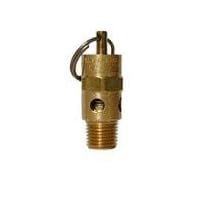
- 1/4" Safety Valve 179 SCFM - 200 PSI
- Free Shipping
- 51 mm Tall x 17.5 hex
- ASME Certified & stamped w/ UV & UB stamps
You've probably wondered just how the value is determined as many compressors make air set to a maximum of 120 PSI to 175 PSI. For whatever the pressure head is set for or can reach, it's the tank rating you use to select your compressor safety valve. You should be using an ASME rated tank, and that PSI rating will be found on an attached plate as its maximum pressure. On unrated tanks, you should use the manufacturer literature or select a safety valve no more that 10% higher than the factory has the cut-off pressure set for. Some think it's a game they can play using the higher rated saftey valve and changing their compressor regulator to a higher pressure. They think that will add performance, but it is only a deadly game.
Unfortunately, using the compressor to build higher pressures only burns up the motor, wears the compressor out faster, uses more power, and creates a deadly situation. An exploding air tank can kill and destroy much around it just like a bomb going off. The safety valve is there to help prevent this, but it can't help a weakened tank that has internal rust damage that has gone too far. Have any pinhole leaks in the tanks bottom side? Does the metal sound different in places when tapped with a small hammer? Get rid of it! They are not repairable and will not operate safely even if using lower pressures under 100 PSI. Water builds up in all tanks during their use. Optimally, it should be emptied often while the tank is in use and should be drain off when the compressor has been shut down. Never leave any water in an air receiver tank.
To check a tank, fill it full of water and pressurize it to see if it leaks or holds at its rating water doesn't compress like air, so a rupturing tank filled with water is less dangerous. Actually, the smart thing to do is have a professional inspect the tank.
Ok, my tank is a brand new replacement the old one had a pinhole leak and I opened the inspection covers and found it to be in bad shape after 30 plus years of use. The new tank is rated 200 PSi @ 650 degrees Farenheit. This 200 PSi safety valve is just what it needed. My compressor is a 175 PSI 2-stage model, but the motor I use is an old rated 2 Hp. That motor is actually a 3 Hp. The motor would overheat and stop before 200 PSI could be reached. So, why I used a 200 PSI safety valve, and not one smaller? Over time a safety valve can lose its calibration and leak at a lower PSI, so you match it to the tank rating to prevent leaks.
Remember I mentioned my new tank was rated 200 PSI @ 650 degrees? Air expands with heat. Should my tank temperature ever get high enough to create pressure in excess of 200 PSI, this safety valve will drain it safely. Safety vales come with all different pressure ratings never exceed what the manufacturer used if yours has become faulty over time.
Oh, and just because my compressor can make 175 PSI, I never set its cut-off pressure that high. A 100 PSI cut-in and a 140 PSI cut-out pressure keeps enough air presure for all my various air tools to stay at their rated CFM and pressures and my compressor and motor never runs hot. Running hotter would also keep more water vapor in the air instead of allowing it to condense out to the botton of the tank. A filter/dryer/and regulator sees to it the air going to my tools is dry and regulated to the pressure required by each tool for a long operation life. Keeping the tank heat down will also extend the life of the safety valve.
There are un-rated safety valves that are user adjustable to different pressures. Using an un-rated tank and or safety valve in a workplace is against the law in most locals. The type valve here is AS250M. This safety valve is ASME rated and has two stamped indentations in the housing body to prevent resetting to a different pressure and it meets OSHA requirements. Manufactured by STEUBY MFG. ST.LOUIS, MISSOURI USA!


No comments:
Post a Comment